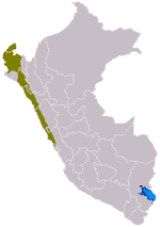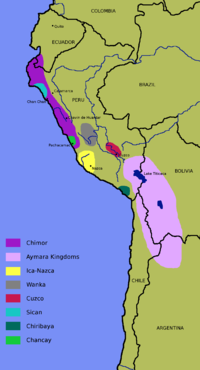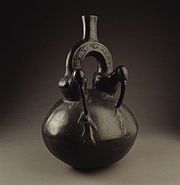
Chimor
Encyclopedia


Chimú Culture
The Chimú were the residents of Chimor, with its capital at the city of Chan Chan, a large adobe city in the Moche Valley of present-day Trujillo, Peru. The culture arose about 900 AD. The Inca ruler Tupac Inca Yupanqui led a campaign which conquered the Chimú around 1470 AD,.This was just fifty...
that ruled the northern coast of Peru, beginning around 850 AD and ending around 1470 AD. Chimor was the largest kingdom in the Late Intermediate period, encompassing 1,000 km of coastline. The greatest surviving ruin of this civilization is the city of Chan Chan
Chan Chan
The largest Pre-Columbian city in South America, Chan Chan is an archaeological site located in the Peruvian region of La Libertad, five km west of Trujillo. Chan Chan covers an area of approximately 20 km² and had a dense urban center of about 6km²...
.
The Chimú grew out of the remnants of the Moche
Moche
'The Moche civilization flourished in northern Peru from about 100 AD to 800 AD, during the Regional Development Epoch. While this issue is the subject of some debate, many scholars contend that the Moche were not politically organized as a monolithic empire or state...
culture. The first valleys seem to have joined forces willingly, but Sican
Sican Culture
The Sican culture is the name that archaeologist Izumi Shimada gave to the culture that inhabited what is now the north coast of Peru between about AD 750 and 1375. According to Shimada, Sican means "temple of the moon". The Sican culture is also referred to as Lambayeque culture, after the name...
was acquired through conquest. They also were significantly influenced by the Cajamarca culture
Cajamarca
Cajamarca may refer to:Colombia*Cajamarca, Tolima a town and municipality in Tolima DepartmentPeru* Cajamarca, city in Peru.* Cajamarca District, district in the Cajamarca province.* Cajamarca Province, province in the Cajamarca region....
and the Huari. According to legend the capital Chan Chan was founded by Taycanamo who arrived in the area by sea.
Chimor was the last kingdom that had any chance of stopping the Inca. But the Inca conquest was begun in the 1470s by Tupac Inca
Tupac Inca Yupanqui
Topa Inca Yupanqui , translated as "noble Inca accountant," was the tenth Sapa Inca of the Inca Empire, and fifth of the Hanan dynasty. His father was Pachacuti, and his son was Huayna Capac. Topa Inca belonged to the Qhapaq panaca....
, defeating the local emperor Minchancaman, descendant of Tacaynamo, and was nearly complete when Huayna Capac
Huayna Capac
Huayna Capac was the eleventh Sapa Inca of the Inca Empire and sixth of the Hanan dynasty. He was the successor to Tupac Inca Yupanqui.-Name:In Quechua, his name is spelled Wayna Qhapaq, and in Southern Quechua, it is Vaina Ghapakh...
assumed the throne in 1493 AD.
Chimú ceramics are all black. It is also known for its exquisite and intricate metal-working, one of the most advanced of pre-Columbian times.

